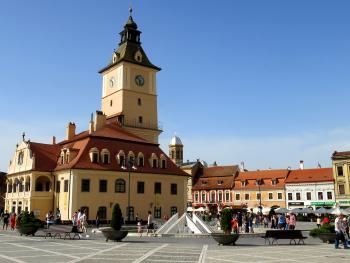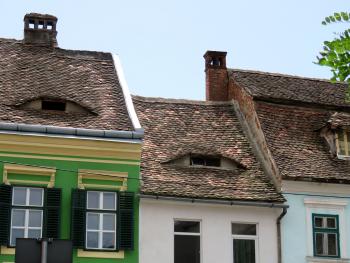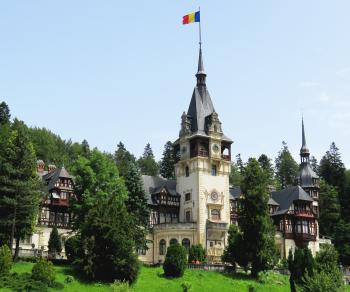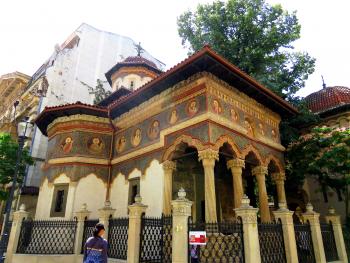A self-drive journey continues on the byways and highways of Romania
This article appears on page 20 of the June 2017 issue.
Following time spent exploring Bulgaria by car in June 2016 (see last month’s issue), my husband, Fred, and I departed Nessebar and headed for Brașov, Romania.
We arrived at the border at around 3:30 p.m. and paid the 10-lev toll ($5.60) to cross. We also purchased the vignette (€8, or $8.70, one week) that was required for driving on Romania’s motorways.
Brașov
As we drove into Brașov, where we would spend the next four days, the first thing we noticed were the large letters spelling out BRAȘOV on the side of Tâmpa Mountain. (The white letters bore a remarkable resemblance to the “Hollywood” sign in Los Angeles.) You can take a cable car up the mountain and walk to the sign.
Our hotel, Vila Katharina (Str. Poarta Schei nr. 20; vilakatharina.ro), was in the Old Town section of the city. The hotel, a renovated villa, is named after Vlad Dracula’s mistress.
The next morning, we had breakfast in the garden. We ordered the “Russian breakfast” for €7, which included toast with caviar, smoked salmon and two soft-boiled eggs with mustard-seed sauce. Then came two delicious crêpes!
This beautifully decorated boutique hotel was my favorite in Romania. (Our room for four nights cost a total of $429.)
Across the street from our hotel was Synagogue Beth Israel, which was open, as Saturday morning services were being conducted.
Heading further into the city, we walked to Catherine’s Gate and the 4-foot-wide Strada Sforii (one of the narrowest streets in Europe).
Near the main square is the Black Church, one of the largest medieval houses of worship between Vienna and Istanbul. Built in 1383 as the Roman Catholic Church of Saint Mary, it became a Lutheran church in 1542, during the Protestant Reformation.
A fire in 1689 destroyed the church’s interior, and its outer walls and roof were blackened from the fire, giving it the name by which it is now known.
We returned to the main square at 6 p.m. for a free walking tour. Our guide, Kinga, provided details about the buildings we had seen that morning.
During the 12th century, Transylvania was sparsely populated and under the control of Hungary. The king of Hungary invited the German-speaking Saxons to settle and defend the region. Today, the remains of Saxon fortresses can be seen throughout Transylvania, and the cities feature Germanic-style architecture. Kinga told us that, once, only Saxons could live inside the walls of the Old Town.
We walked through Catherine’s Gate and the Romanian section of town, known as the Schei District, to St. Nicholas Orthodox Church. We were fortunate to find the church open.
Built in 1495 on the site of an older church, St. Nicholas and its school were the educational center of Brașov.
Our tour ended at the Black Tower on Starja Hill, one of the watchtowers built in 1494 to protect the city.
Day-tripping
The following morning we took Route 1 toward Sighis¸oara. At Faˇgaˇras¸, we stopped at the fortress there. A moat surrounding the fortress plus weeping willows on the banks and families of ducklings paddling in the water made it a picturesque setting.
Originally a fortress, this citadel became a palace and, in the Communist era, a prison.
We spent an hour there before continuing north on unmarked roads through several villages. It was Sunday, and we passed several families on the road in their horse carts.
We arrived in the medieval city of Sighis¸oara, a UNESCO World Heritage Site, around 2 p.m. The city’s clock tower, with nine of the original 14 towers still standing, is the focal point. Colorfully painted houses show the Saxon influence.
Sighis¸oara is the birthplace of Vlad the Impaler (aka Vlad Dracula). There is a statue of Vlad in the center of the city, and the house where he was born is now a restaurant.
The town was picturesque but filled with tour groups.
Returning to Brașov, we stopped about halfway, at the fortress in Rupea (entrance fee, RON10, or $2.40). We spent 40 minutes on the grounds, which was enough time. There were written explanations in English, and the site offered great views of the countryside.
Road trip
Next on our itinerary was Sibiu, known for its German heritage. The drive from Brașov took two hours. Upon our arrival, we parked a few blocks from the main plaza, Piat¸a Mare.
Sibiu was designated as a European Capital of Culture in 2007, so many of its buildings had been restored. We visited the Holy Trinity Roman Catholic Church, located next to the impressive City Hall. This beautiful church was built in 1733 in Viennese baroque style. Mass is conducted in three languages: Romanian, Hungarian and German.
At the next plaza, Huet Square, we visited the Evangelical Cathedral, built in the 14th century on the site of an old Roman basilica. The uneven, well-worn floors confirmed the church’s age.
There were Baroque carvings on the walls and a large fresco, painted in 1445. The 6,000-pipe organ is the largest in Romania.
After three hours exploring Sibiu, we drove back toward Brașov, taking the turnoff to the Transfaˇgaˇraˇss¸an highway, listed as one of the top roads to drive in the world. It was constructed in the early 1970s, during the dictatorship of Nicolae Ceaus¸escu, as a strategic route to allow the transport of troops in case of an invasion. With numerous hairpin turns and tunnels, it winds its way up the Faˇgaˇras¸ Mountains to an altitude of 6,699 feet.
Due to the heavy snowfall, the road is usually only open in the summer months. The road had been opened the day before or visit, so many snowbanks were still visible along the sides of the road. It was very crowded, and the maximum speed we could drive was 25 mph. At the summit, there was a cable car that allowed spectacular views of the highway.
On to Bucharest
Leaving Brașov, Fred and I drove south toward Bucharest, the country’s capital. We wanted to visit one of the many famous Transylvanian castles on our way, and, originally, we thought we would visit Bran Castle, of Dracula fame, but after talking with other travelers as well as locals, we opted for Peles¸ Castle.
We drove south on the E60 to Peles¸, situated at the foot of the Bucegi Mountains in the town of Sinaia. The entrance fee of RON25 ($6) included a guided tour of the ground floor and the upper rooms.
The castle, with its more than 160 rooms, was the summer palace of the former king of Romania. Commissioned by King Carol I in 1873, it was completed 10 years later. The castle continued to be expanded over the next 40 years and was used by the royal family until 1947.
The interior was beautiful, featuring stained-glass windows and paneled walls.
The castle was the first European castle to be electrified, and it had indoor plumbing and heat and a central vacuum system.
We left Sinaia at around 2:30 p.m. and continued to Bucharest to the Rembrandt Hotel (11 Smarden St.; rembrandt.ro), located in the Old Town’s pedestrian center.
As we entered Bucharest, we noticed an abrupt demarcation from the agrarian countryside to a cosmopolitan city with broad avenues and large parks. (Later, we learned that before World War II, Bucharest was called the Paris of the East.) Romanians were influenced by the French, and many of the buildings have French names. They also frequently use “Merci” to say “Thank you.”
The next morning, after enjoying the buffet breakfast that was included in the cost of our room ($369 for three nights), we joined a free walking tour. With our guide, Livia, we walked through Old Town and stopped at Hanu’lui Manuc (aka Manuc’s Inn). Built in 1808, it was the oldest-operating hotel in Bucharest — now renovated and reopened as a restaurant.
We also visited Stavropoleos Monastery. Its small church, built in 1724 in the Brâncovenesc style, is an oasis in the heart of Old Town. With its carved-stone decorations and its frescoes, this is one of the oldest and most beautiful churches in the city.
Next was the Natural History Museum on Calea Victoriei, or Victory Street, a historic street that was originally part of the trade route between Bucharest and Brașov. Then we walked through Old Town to Revolution Square, and Livia gave us some insight into life in Romania during the dictatorship of Nicolae Ceaus¸escu and the revolution that finally overthrew him.
After lunch, we walked to the Palace of the Parliament, the second-largest administrative building in the world, after the Pentagon. It was built with no expense spared by Ceaus¸escu, who did not live to see it completed. It contains 1,100 rooms and requires a staff of 200 personnel to clean it. (It reportedly costs €15 million per year to maintain the structure.) Our one-hour tour covered only 4% of the building.
From the balcony, you can gaze down the broad boulevard that connects the Palace of the Parliament to the city. The boulevard is wider than the Champs Élysées in Paris and features 42 fountains.
The walking tour ended at Revolution Square, where Livia elaborated on the student protests and the final days of the Ceaus¸escu regime. It’s been over 25 years since the overthrow of its Communist dictator, and the country is now beginning to have a stable government.
We returned to Manuc’s Inn for dinner and had a table close to the folk-dancing show. Musicians played instruments that looked like a violin and dulcimer, and one played a ceramic pipe while dancers performed traditional village dances.
A final look at Romania
The following day, we took the Metro (RON5, round trip) to Victory Plaza, then walked to the National Museum of the Romanian Peasant. The museum was under renovation, but we did see interesting exhibits of ceramics and folk customs.
After an hour, we took the Metro back to Bucharest’s Old Town and walked to the Old Jewish section, located behind the Carrefour shopping center. We found the old synagogue, now the Jewish Museum, but it was closed, as it, too, was under renovation.
We returned to Manuc’s Inn for dinner and had the recommended S¸arba white wine. The bill for a delicious hummus with tomatoes, onions and olives, a fish stew, another appetizer and cherry pie for dessert was RON160 ($40) — well worth it!
We only had a week in Romania, so we limited our exploration to the region of Transylvania. We were not disappointed. I learned and appreciated the complex history of the country.
Back to Bulgaria
The next day we returned to Bulgaria for the final leg of our 4-week journey. After an hour and a half of driving, we arrived at the border and were pleasantly surprised that there was no line. We got through the crossing in 30 minutes.
We continued on Route 106, through the Pirin Mountains, to Melnik, one of the southernmost towns in Bulgaria. We stayed at Chavkova House (112 Melnik Str.) for $84 for one night. We had dinner at the hotel, which included a bottle of No Man’s Land 600 Chardonnay from the area. Fred had the grilled meats, and we shared two appetizers — French fries with tomatoes and cucumbers and the other a combination of eggplant, garlic, tomatoes and parsley — all for 64 lev ($35).
Melnik, set against impressive natural sand “pyramids,” has long been known for its wine.
At the Villa Melnik Winery (villa melnik.com), we took a tour led by Militza Zikatanova, the daughter of the owner. Her father, Nikola Zikatanov, grew up in the village of Kapatovo, situated at the base of the winery.
The family had grown vines and made wine until the Communist era, when the land was taken. After the dissolution of Communism in Bulgaria, families were given their property back, and her father purchased the land from the 100 family members who had collectively owned it, creating the current vineyard.
The winery opened its state-of-the-art operation in 2013 and has won several awards.
They offered several tasting options, and we selected the 15-lev tasting of six premium wines. We spent two hours at the winery and purchased several bottles of wine.
Heading home
When we returned to Melnik, we walked to the end of town and up the hill to the Kordopulov House Museum (entry, 3 lev). The house was built in 1754 in the National Revival style and covers three levels.
It was owned by Manolis Kordopulos, a rich Greek wine merchant. The Ottoman influence was apparent throughout the house.
The winery on the ground floor is still in operation and offers tastings. We also walked through the tunnels dug into the rock where wine barrels were stored. The cellar can hold 300 tons of wine.
The following day, we checked out of the hotel and headed back to Sofia, where our journey had begun. Along the way, we took a detour to Rupite, a village known for being the birth and burial place of blind clairvoyant Baba Vanga (1911-1996). The village, located in the crater of an extinct volcano, had several hot springs.
It’s a place of pilgrimage and gets very crowded with locals on weekends. Despite being a popular destination, it was not easy to find.
We checked into the Ibis Sofia Airport Hotel for the night ($48). Returning our rental car couldn’t have been easier. YES, our car rental company, came to the hotel to pick up our car and we took the hotel’s shuttle service to the airport the next morning for our flight home.




